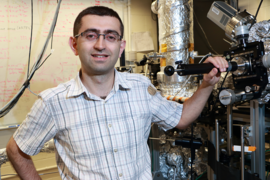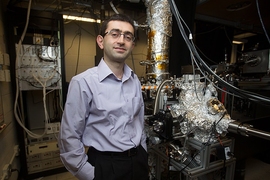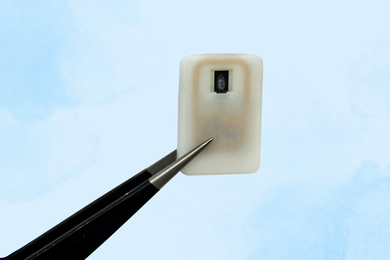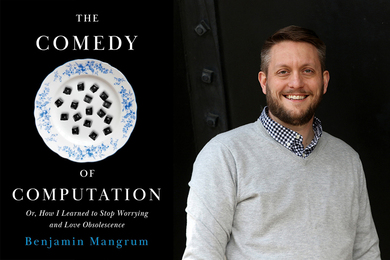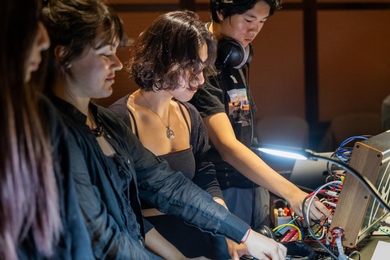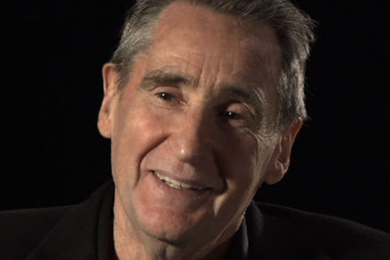In 2013, MIT physicists showed for the first time that shining powerful mid-infrared laser light on solid bismuth selenide produces Floquet-Bloch states, which are characterized by replicas of electronic energy states inside a solid with gaps opening up at crossing points of replica states. The same external light also interacts with free electron states immediately outside the solid producing a competing state, called the Volkov state, which is gapless.
Now, researchers led by Nuh Gedik, the Lawrence C. (1944) and Sarah W. Biedenharn Career Development Associate Professor of Physics, have shown that changing the light’s polarization eliminates competition from Volkov states, yielding pure Floquet-Bloch states.
MIT graduate student Fahad Mahmood and postdoc Ching Kit (Chris) Chan, demonstrate experimental proof and offer a mathematical framework for understanding interference between these competing states as a function of electron momentum. The results are published online in Nature Physics.
“Fahad figured out a clever way of quantifying the interference of these two states with each other, and then from this interference, we can deduce selectively, this part is coming from the outside, this part is coming from inside,” says Gedik, who is senior author on the new work. “I think this is a big step because if you eventually want to realize a new state of matter based on periodic excitation, you really need to be able to isolate just the contribution of the electrons inside the solid.”
MIT co-authors of the study are Zhanybek Alpichshev, a postdoc in Gedik’s group; recent physics alumnus Dillon R. Gardner PhD ’15; Professor Young S. Lee; and William and Emma Rogers Professor of Physics Patrick A. Lee.
Proportional bandgap
Floquet-Bloch states, occurring on incredibly fast time scales, are observed using an experimental technique called time-and-angle-resolved photoemission spectroscopy (Tr-ARPES). This consists of using a mid-IR laser pulse, with energy below the bulk band gap of the material, to stimulate electrons in the solid. A second laser pulse, at a lesser intensity, overlaps the first and leads to emission of electrons, which are collected in a time-of-flight analyzer that records their angle of emission and energy. “We study the photoemitted electron intensity as a function of the electron energy and momentum,” Gedik says. “If you’re using this technique, it’s super important to be able to selectively, only, probe the photo-excited state inside the solid, and this paper gives you a way,” Gedik explains.
The researchers also show that the value of the artificially induced bandgap is proportional to the square root of the intensity of the light. “That really means it is proportional to the electric field, rather than the intensity, so this is what is actually expected from all this theory work that this gap would actually scale with the electric field of the light,” Gedik says.
The new work yields higher resolution for experimental demonstrations of replica electronic levels, which are also called sidebands, and also offers a theoretical explanation for distinguishing Floquet states from Volkov states. “It was very helpful to have Patrick Lee and his postdoc [Chan] help with the theory. I think it would have been very challenging without their help,” Mahmood says. “That close collaboration helped us a lot because now we can make predictions of exactly how the interference would behave as a function of this electron momentum and you can see that theory and experiment match really well for different directions of electron momentum.”
Hybrid states
Interest in graphene and topological insulators such as bismuth selenide triggered a quest for ways to artificially stimulate a bandgap in them so they could be used for electronic devices. Gedik’s recent work focuses on using periodic light bursts to accomplish this. Although the electrons don’t absorb the light, they react to the electric field by forming a hybrid, or dressed, state between electrons and photons. This effect only occurs when both electrons and photons are present together, and it changes the electronic energy levels inside the material. Changing electronic properties through chemical processes, such as inserting another element into the solid, are usually permanent, but changing the properties of electrons with light excitation is reversible and controllable. “You can just change the intensity of the light, the frequency of the light, or polarization of the light,” Gedik says.
The electronic states are graphically represented by a Dirac cone, which plots energy versus momentum for electrons. Like ripples from a stone dropped in water or echoes of sound, stimulation by laser pulses results in these repeated cones, which are the hybrid photon-electron states. Gaps appear in the energy spectrum where these bands cross.
Lee, who contributed to the theoretical work in the new paper, says, “This work represents an important experimental progress in creating novel laser-driven electronic states, called Floquet states, on the surface of materials. We found that the traditional interpretation of the data was not adequate because of extrinsic effects not considered previously. Once this was understood, we found a tunable way to manipulate these Floquet states. The result may aid in the design of light-controllable electronic devices.”
Experimental challenges
To generate the light-driven state, Mahmood used mid-IR light pulses that diverge and lose power rapidly as they propagate. Guiding these pulses onto a small sample in a vacuum chamber while maximizing their power required special optical setups developed in the Gedik Lab. The time-of-flight analyzer is also relatively new requiring careful alignment. “We had to make sure that our beam was focused in such a way to get the best resolution out of our instrument,” Mahmood says.
The results show that the interference between Floquet-Bloch and Volkov states depends strongly on the polarization of the light. This polarization determines the orientation of the electric field with respect to the sample plane. Since the Volkov state is primarily activated by an out-of-plane electric field, switching the light polarization to one with only an in-plane electric field eliminates the Volkov state.
“This is a very challenging experiment, as it requires performing detailed photoelectron spectroscopy measurements on a transient photo-driven state that lasts merely fractions of a picosecond,” says David Hsieh, assistant professor of physics at Caltech. “The Gedik group has succeeded not only in directly visualizing the spectrum of this transient state, but also in quantifying and controlling the electromagnetic coupling between different energy bands of the transient state. This provides an interesting opportunity to use optical excitation as a means to engineer a desired materials response.”
Future possibilities
It may be a bit of science fiction at this point, but one possibility, according to Gedik, is using this technology to spatially pattern the light excitation which could lead to devices with customized geometries. To get there, he says, “We need to do this basic work, which is to understand what these states are and how they interact with other states.” Mahmood continues to study how long it takes for these Floquet states to form and to disappear. “All of this needs to be understood before we can move onto there,” Gedik says.
Work also remains to be done to understand how the electrons relax down from the Floquet states. It is especially important to understand how they interact with other states inside the solid such as vibrations of the lattice called phonons or collective excitations of the electrons called plasmons.


